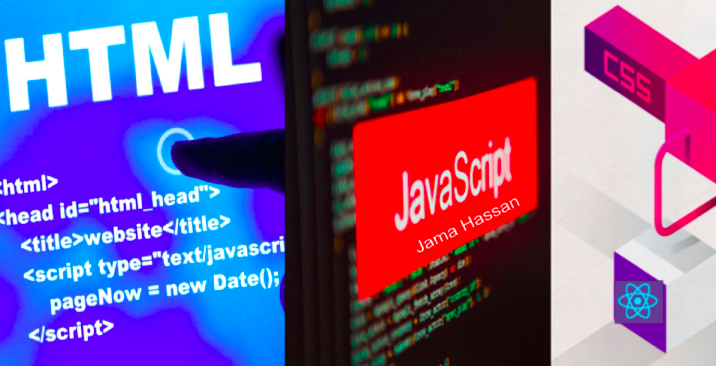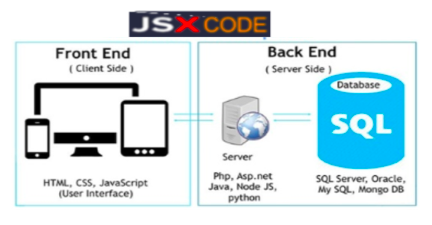
- World-Wide-Web Codes:

- UI Engineer:
- Front End
- Back End
- SPA's
- The Big Picture of API's
- REST SERVICES ?
- So what is HTTP, Really?
- Network layers Protocols
- Node.JS
- Angular
- React
- React Native

- UI Engineer:

What The Heck is Back-End
The back end is the machine that runs a site-the user doesn't see it or directly interact with it as
with client-side technology, but it's always running in the background, delivering smooth functionality, a desktop-like experience, and information from the database right into the browser.
Back-End Technology: The Role of the Back-End Web Development process.

 Back-end code adds utility to everything the front-end designer creates.
The back end is a combination of a database and a software written in a server-side language, which are run on web servers, cloud-based servers, or a hybrid combination of both. A network's server set-up can vary, with the server-side workload divided up between various machines (e.g., a server dedicated to housing the database).
This server-side application directly interacts with the database via an application programming interface (API), which pulls, saves, or changes data.
The data are returned and converted into front-end code a user interacts with: filling out a form, creating a profile, shopping online, etc.
THE BACK-END DEVELOPERS' TOOLBOX
Back-end developers create and maintain the entire back-end function outlined above. The back-end developer takes finished front-end code and gives it working functionality for instance, making values in a drop-down menu possible by building the infrastructure that pulls values from the database.
Responsibilities of the Back-End can include
Back-end code adds utility to everything the front-end designer creates.
The back end is a combination of a database and a software written in a server-side language, which are run on web servers, cloud-based servers, or a hybrid combination of both. A network's server set-up can vary, with the server-side workload divided up between various machines (e.g., a server dedicated to housing the database).
This server-side application directly interacts with the database via an application programming interface (API), which pulls, saves, or changes data.
The data are returned and converted into front-end code a user interacts with: filling out a form, creating a profile, shopping online, etc.
THE BACK-END DEVELOPERS' TOOLBOX
Back-end developers create and maintain the entire back-end function outlined above. The back-end developer takes finished front-end code and gives it working functionality for instance, making values in a drop-down menu possible by building the infrastructure that pulls values from the database.
Responsibilities of the Back-End can include
Database creation, integration, and management e.g., MySQL, SQLite, PostgreSQL, and MongoDB. SQLite is lightweight and fast, making it a very popular alternative to a larger MySQL driver.
Using back-end frameworks to build server side software, like express.js
Web Server Technology e.g., J2EE, Apache, Nginx (popular for static content, like images, HTML or CSS files), and IIS Cloud computing integration e.g., public cloud providers like Amazon Web Services, or private cloud environments Server-side programming language-like PHP, JavaScript, Perl, Ruby, and Python, when implemented with the server-side development environment, Node.js
Operating systems: Linux- and Unix-like operating systems, MacOS X, Windows Server
Content management system (CMS) development, deployment, and maintenance
API integration Security settings and hack prevents Reporting-generating analytics and statistics like system reports of server load, number of visitors, geography of visitors, etc.
Backup and restore technologies for website's files and DB.

The following image is the visual representation of Back-end process.
 Back-end code adds utility to everything the front-end designer creates.
The back end is a combination of a database and a software written in a server-side language, which are run on web servers, cloud-based servers, or a hybrid combination of both. A network's server set-up can vary, with the server-side workload divided up between various machines (e.g., a server dedicated to housing the database).
This server-side application directly interacts with the database via an application programming interface (API), which pulls, saves, or changes data.
The data are returned and converted into front-end code a user interacts with: filling out a form, creating a profile, shopping online, etc.
THE BACK-END DEVELOPERS' TOOLBOX
Back-end developers create and maintain the entire back-end function outlined above. The back-end developer takes finished front-end code and gives it working functionality for instance, making values in a drop-down menu possible by building the infrastructure that pulls values from the database.
Responsibilities of the Back-End can include
Back-end code adds utility to everything the front-end designer creates.
The back end is a combination of a database and a software written in a server-side language, which are run on web servers, cloud-based servers, or a hybrid combination of both. A network's server set-up can vary, with the server-side workload divided up between various machines (e.g., a server dedicated to housing the database).
This server-side application directly interacts with the database via an application programming interface (API), which pulls, saves, or changes data.
The data are returned and converted into front-end code a user interacts with: filling out a form, creating a profile, shopping online, etc.
THE BACK-END DEVELOPERS' TOOLBOX
Back-end developers create and maintain the entire back-end function outlined above. The back-end developer takes finished front-end code and gives it working functionality for instance, making values in a drop-down menu possible by building the infrastructure that pulls values from the database.
Responsibilities of the Back-End can includeDatabase creation, integration, and management e.g., MySQL, SQLite, PostgreSQL, and MongoDB. SQLite is lightweight and fast, making it a very popular alternative to a larger MySQL driver.
Using back-end frameworks to build server side software, like express.js
Web Server Technology e.g., J2EE, Apache, Nginx (popular for static content, like images, HTML or CSS files), and IIS Cloud computing integration e.g., public cloud providers like Amazon Web Services, or private cloud environments Server-side programming language-like PHP, JavaScript, Perl, Ruby, and Python, when implemented with the server-side development environment, Node.js
Operating systems: Linux- and Unix-like operating systems, MacOS X, Windows Server
Content management system (CMS) development, deployment, and maintenance
API integration Security settings and hack prevents Reporting-generating analytics and statistics like system reports of server load, number of visitors, geography of visitors, etc.
Backup and restore technologies for website's files and DB.


 Printer Friendly Version
Printer Friendly Version